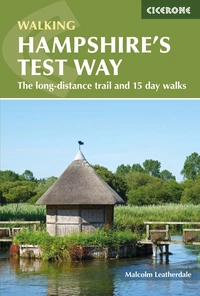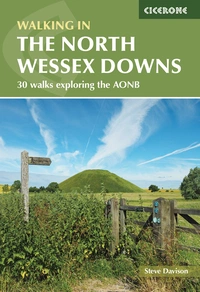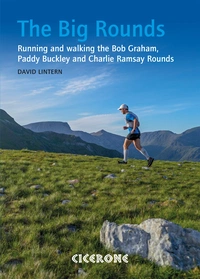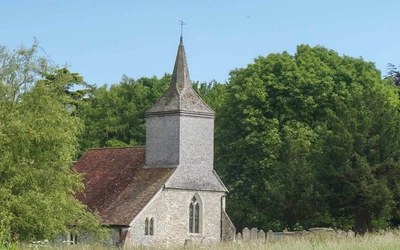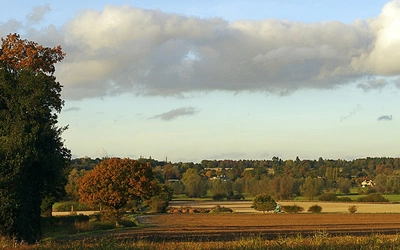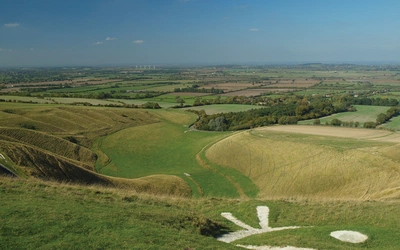Chalk hills and watermills along Hampshire's Test Way
Malcolm Leatherdale, author of the Cicerone guidebook to the Test Way, explores the River Test and its important economic history. He visits plenty of mills along the way, including one that used to make bank note paper for the Bank of England.
Imagine a land where time just hangs – where bird song flits along a corridor of sparkling white and green; where you can look out from the North Wessex Downs and be wrapped in a sense of wonder as red kites soar from one horizon to the next.
Such a place is the glorious chalk escarpment called Inkpen Beacon which, improbable as it must seem, once used to be at the bottom of the sea!
It is also happens to be the start of the Test Way – described in Walking Hampshire’s Test Way – which leads gently to the Eling Tide Mill near Southampton Water. Imagine as well, that under your feet and far below are cavernous chalk aquifers that have collected rain and snowmelt for millennia.
These aquifers gradually release their accumulated water like giant sponges – creating the springs that are the life force of the chalk streams flowing through the rolling downland of the Hampshire Basin. One such is the River Test – an iconic chalk stream – that rises in the hamlet of Ashe, which as the crow flies is about 22km (13.5 miles) south east of Inkpen Beacon.
Ashe lies about 1.5km (1 mile) to the east of the small town of Overton and the emergent River Test literally gurgles to the surface unceremoniously in the middle of a field.
The Test and the Test Way take a while to find each other and first converge at Longparish – about 13km (8 miles) from Ashe and 26.5km (16.25 miles) from Inkpen.
We could, of course, simply trek – appealing though that would be – from Inkpen towards Southampton Water, which is 71km (44 miles) away, but there is much more to discover. Mixed in with the landscape are a number of historic sites that were used to create economic prosperity as well as meeting the needs of everyday life. For example, watermills were constructed along the River Test as far back as medieval times and continued to operate until water power was gradually replaced by more efficient sources of energy.
Money in mills
In 1724, Laverstoke Mill – just to the west of Overton – began to produce bank note paper for the Bank of England.
Laverstoke Mill’s owner at the time was Henri Portal, a Huguenot refugee who had left France to escape extreme religious persecution. It should perhaps be acknowledged that he was also a friend of the then governor of the Bank.
Bank note paper continued to be produced at Laverstoke for more than two and a half centuries before production was relocated to Overton. Laverstoke Mill has though now reinvented itself as a gin distillery – which is quite apt as the water of the Test has often been described as ‘gin clear’!

Close by is Bere Mill, astride the Test just beyond the hamlet of Freefolk. It was also once used by the Portal family to produce paper for a variety of uses. In February 2018, Bere Mill – now a private residence – suffered extensive fire damage but is being rebuilt by its owners.
Next along the river is Town Mill at Whitchurch. Town Mill was originally used for grinding corn but is now a private residence. Although the present building dates from the 18th century, a mill on this site is recorded in the Domesday Book in 1086 so it can reasonably be assumed that there has been a succession of mills here since then.
Before the advent of mills, corn was ground using two mill stones – known as quern stones. The lower stone was fixed and the upper stone – with a hole in the middle through which the corn could be fed – was manually ‘turned’ – no doubt requiring great effort. Corn mills were the most common type of mill (including windmills) in feudal and medieval times.
If you wanted to get on in life and raise your status from that of a ‘lowly serf’, one route was to become a miller as the job had a higher social standing and was quite well paid. You would have had to keep on the right side of the Lord of the Manor, however, as he invariably owned the mill.
There was even a class divide in the type of bread consumed by the various sectors of society. White bread – more refined – usually found its way to the tables of the higher echelons, but brown or darker, more coarse bread – less well ground – was more likely to be the fare of the lower orders.

Conversions and clothing
In the middle of Whitchurch is the Whitchurch Silk Mill, the origins of which go back to 1815 when it was built by William Hayter to be used, it is thought, as a saw mill and furniture factory. Unfortunately, Mr Hayter’s financial position rapidly deteriorated and in 1817 he was made bankrupt – an ominous fate at a time when debtors could be imprisoned.
In the same year the mill was acquired by William Maddick, a silk merchant from Spitalfields in London, who converted it to a silk mill and continued to operate it as such until 1844. A succession of owners followed until 1985 when production was discontinued and the mill faced the risk of being developed. In 1990 it was reconstituted as a charitable trust. Although there are four working silk mills in England, Whitchurch is the only one open to the public. In 2016 the mill was awarded heritage lottery funding of £1.7m.
The Fulling Mill at the southern end of Whitchurch is now a private residence. Fulling was part of the process of making wool more suitable for use as cloth or fabric. Fulling required moisture, heat and pressure to beat and compact the wool and shrink it to make it thicker. The process also helped to clean the wool. The system involved heavy wooden hammers being raised and dropped onto the wool as it was being fed through a trough.
Next is Longparish, about a quarter of the way along the river, where there were two mills used for grinding corn. Upper Mill, now known as Mill House, has been converted to residential use but part of the original mill has been restored.
Fishing the Test
Lower Mill, towards the southern end of the village, provides opportunities for fly fishing along its beat.
The River Test – just one of 200 chalk streams worldwide – is without doubt in the fly fishing premier division.
For many of its adherents, fresh water fly fishing has some of the tenets of a spiritual philosophy – part belief, part ritual, and a clear expectation that joy awaits at any moment. It might also be claimed that the River Test could be the ‘holy grail’ of fly fishing.
If you are of a mind that fly fishing is simply fishing with a ‘fly’ attached to the end of a fishing line, you are fairly wide of the mark. The aim of the fly maker is to match or replicate the real thing and, despite being artificial, some types of fly also need to stay on top of the water to fool the fish – no mean feat!
At Horsebridge – south of Stockbridge and in the middle of the Test Valley – is Horsebridge Mill, a former corn mill that has been converted to modern commercial use. It has for many years been occupied by a company engaged in the field of designing and manufacturing educational training equipment for the engineering sector.
Within a few metres is the route of the Test Way, which keeps to the old track bed of the former Andover to Redbridge (Southampton) railway. The railway was affectionately known as the ‘Sprat and Winkle’ line but ceased operating in 1964 – a casualty of the Beeching cuts at the time.
A few miles further along from Horsebridge lies the market town of Romsey. At the southern end of Romsey is Sadler’s Mill, where there has been a mill since medieval times, as the blue plaque on the wall proclaims. It was used variously as a corn and grist mill producing flour. The mill was rebuilt by the first Lord Palmerston in 1748. After lying derelict for many years it was restored in 2005 and subsequently converted to residential use.
Finally, after another 15km (9 miles) we come to the Eling Tide Mill at Totton and although it is not on the Test it is located at the very end of the Test Way, adjacent to Eling Wharf. There has been a mill on this site for more than 900 years. The rebuilding of the present mill started in the late 1770s following storm damage and took until around 1785 to complete.
Eling is just one of two such working tide mills in England and regularly produces flour for sale.
It has recently been fully restored with the help of £2m heritage lottery funding. There is also an excellent visitor centre. Not far away the Test also ends its journey as it meets Southampton Water.
Hopefully this article has encouraged you to explore some of the Test Way and its history. Maybe see you there!

